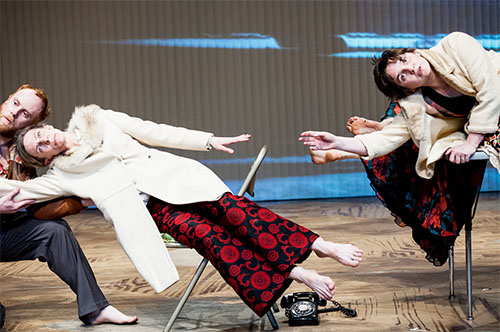By SUSAN REITER
It sounds like the line-up for an especially eclectic film festival: Terms of Endearment, Dr. Zhivago, and the 1961 French thriller Le Cercle Rouge. Instead, those movies are the basis of Alan Smithee Directed This Play: Triple Feature, the latest adventure in the unexpected from Big Dance Theater.
Playing through October 4 at BAM, <em>Alan Smithee</em> is intriguingly difficult to categorize, and that's long been a hallmark of BDT's work. Founders Annie-B Parson and Paul Lazar have specialized in shows that draw on literary---and more recently, cinematic---sources, incorporating an often wild mix of elements to generate works that gleam with their own inner logic and often chaotic beauty. (New Yorkers might know Parson's work as the choreographer of the Public Theater's Here Lies Love, while Lazar, a busy actor who performs in Alan Smithee, is currently in rehearsals for the upcoming Theater for a New Audience production of Marlowe's Tamburlaine.)
To that end, traditional narrative, or even specific characters, are not the focus of Alan Smithee, which was initially conceived as a theatrical triptych incorporating the film scripts. But once she, Lazar, and the performers began to work, Parson says, elements of the films "just started speaking to each other. I would say it was more an exercise in collage. This piece has taken a really long time to make. It's sprawling."
"Alan Smithee" is the pseudonym used by directors who are unhappy with the final outcome of a film. As Parson notes, though, she and Lazar consider a degree of creative chaos a necessity. (They're co-directors here, and Parson is also choreographer.) For them "the title is like a wry joke," she says. "The work starts to get out of control creatively, in a good sense. In terms of what we're doing, we <i>want</i> it to do that---to have its own life. We want it to be something that we never ever imagined when we started."
Asked how they came to focus on these particular films, she explains, "Terms of Endearment came up because Paul and I love, and are really interested in, the acting. Also, its world, that 1970s suburbia, is what I grew up in. So that's very familiar, and I loved the idea of exploring that. Thinking that we needed something very contrasting, we considered using something epic---large-scale, momentous, and historical. Of course Dr. Zhivago came up as the iconic piece that reflects that kind of need. We loved the scale of the acting; it's all so extremely stylized. But the screenplay had murdered the novel and reduced it to this very simple love story. So we ended up using, I think, not really any of the text from the film. But we used a lot of the novel's text. What we used from the film are the clothes and the acting style."
Meanwhile, Parson had been commissioned to create a short dance based on a specific scene from Jean-Pierre Melville's Le Cercle Rouge, and she wanted to bring that material into the mix for further exploration. "I used the French film mainly as interstitial material and for its directing style," she says.
She continues, "There's no uniform borrowing. It's all sampled, but it's all sampled in very different ways. We're taking what we want and leaving the rest. You will see specific characters from the films, but they will be portrayed by different people at different times."
The cast of seven includes mostly BDT veterans. Tymberly Canale, an especially evocative performer who has worked with BDT for nearly 20 years, says that being part of their process requires "an ability to collaborate and to be inventive with movement. We really concern ourselves with rhythm and motion and action and how action defines character. We approach everything choreographically. Even the way a speech is delivered is approached in a choreographic way, with principles of time, space, energy. We think of it all as a dance."
Canale adds, "For Alan Smithee, we were dealing with movie scripts and sounds bites from movies, using the rhythm of the language to create the rhythm of the choreography. This was a really unique process, amid all my experiences with BDT. Annie-B had a really fiery energy, like an impetus to get something out. It was a very demanding process, trying to keep up with her mind in the creation of this piece."
---
Susan Reiter is a journalist based in New York City
Photo by Brad Harris
